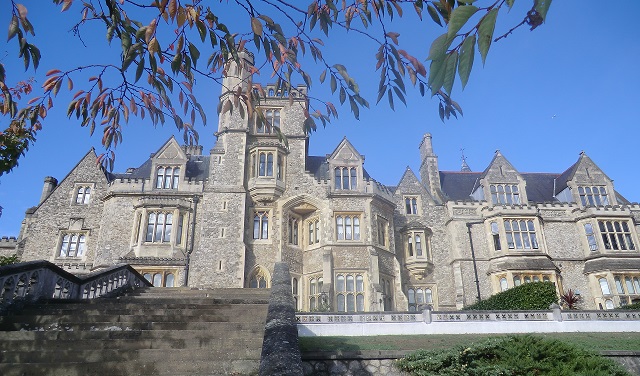Not far from the top of Stanmore Hill, on the corner of Wood Lane, stands the magnificent Stanmore Hall. There are not many buildings in London that can boast the sort of past that Stanmore Hall has witnessed. It was home to a record-breaking balloonist, private residence to a man that could lay claim to all the oil in Persia, and founder of British Petroleum. Restyled by the eminent British architect Brightwen Binyon, decorated by the 19th century's most celebrated designer William Morris, home to the Allied Expeditionary Air Force during the war, nearly lost to a great fire in the seventies, and later becoming UK home to the Swedish automobile manufacturing company Volvo. Today this wonderfully gothic castle has been converted into luxury apartments, and can boast a grade II* listed status.
In the Beginning
The history of the plot of land around the current Stanmore Hall can be traced back as far as the mid 1700’s and was in the possession of one of the wealthy land owners The Duke of Chandos who lived at Canons but owned much of the land around this part of Stanmore. This particular site was the locality of the families Dower House. Dower Houses were generally built by the Lord of the Manor, an estate owner or nobility, and on the death of the titled peer, his widow often known as the ’dowager’, would usually move into the dower house from the larger family house whilst the new heir occupies the now vacated principal house. The land and house were purchased in 1780 by one James Forbes. Forbes also bought Warren House and Bowling Green House, in time he would also purchase the land between them and many of the fields adjoining Denis Lane consolidating them into a serious piece of real estate.
Forbes was in the service of the East India company and during his seventeen years in India he took an active interest of all aspects of Indian life, including botany, ethnology, and architecture. When he returned home to Stanmore in the 1780’s he brought with him his huge collection of notebooks, running into over fifty thousand pages, filled with sketches of animal’s, landscapes and religious objects. Forbes significantly extended Dower House and had the grounds elegantly laid out. Their centrepiece was an octagonal pergola which Forbes had erected, and it was surrounded by Indian Sculptures. After Forbes sold up to move abroad the house went through many hands before it was bought be one Thomas Teed of Argyll House in Richmond, Surrey.
He lived there for the next seven years with his wife and young daughter Ellen Julia; they were the last residents of Dower house. The cost of repairs on the old house were mounting up and in 1842 Thomas decided to redevelop the property. It sat in its own grounds and being near the top of Stanmore Hill when the plans were drawn up it was decided to swing the entire plane of the property around in a south easterly direction to capitalise on the wonderful views over Harrow. The man in charge of overseeing this project would be the developer Matthew John Rhodes.
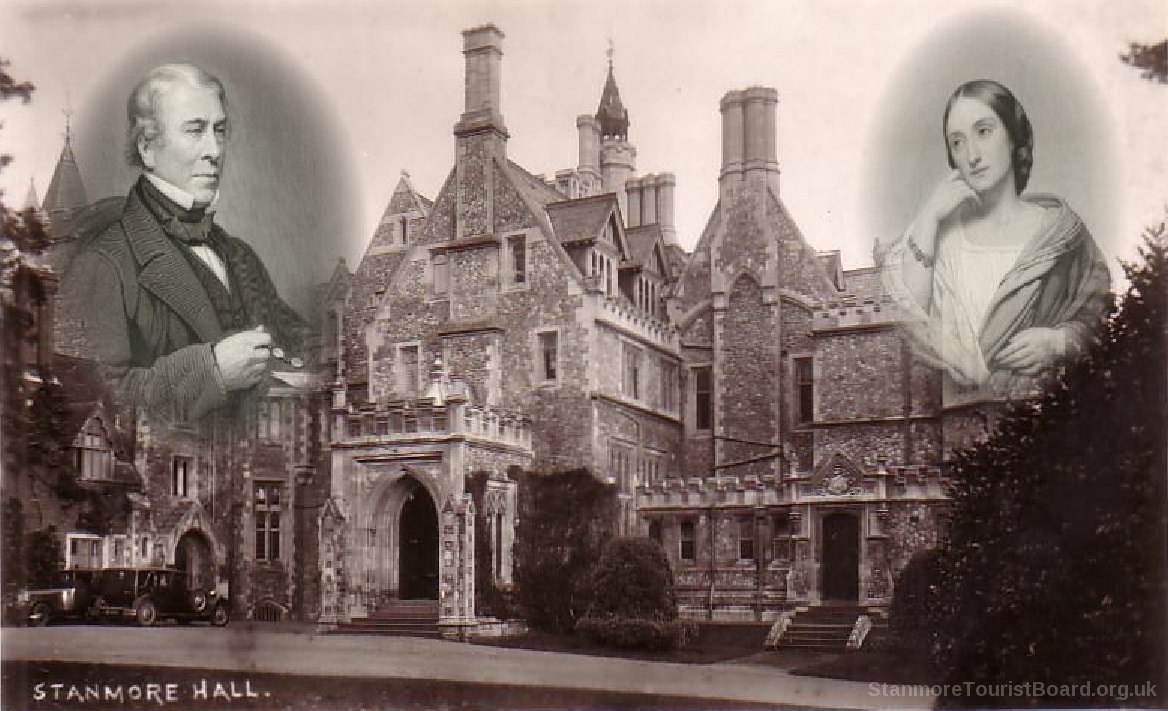
The Hollonds
Stanmore Halls first owners were Thomas Teed’s daughter Ellen and her husband Robert Hollond who moved into the newly built property in 1847. Robert had had quite a colourful life; he was a lawyer, businessman and member of Parliament, standing as a member of the Whigs party representing the constituency of Hastings. But he was known the world over due to his ballooning exploits. On 7 November 1836 Robert and two of his friends from the Aeronautical Society of Great Britain, set a ballooning distance record flying to Weilburg, in Germany from Vauxhall gardens in London. Robert not only took part in the adventure he also bankrolled the whole expedition himself. They flew a distance of some 480 miles in just 18 hours. This was the quickest time that man had achieved up until this time, and was such a feat that the record stood for eight decades, and would only be beaten in 1914, when man started using powered flight and the German, Karl Ingold beat it in his Mercedes-powered Aviatik biplane.
Ellen was well known in her own right as an authoress always interested in promoting the welfare of others, especially by the generous donation of money to good causes. In a time where the woman would stay home and look after the children, one of her ideas was to get ladies into the workplace and so in London in 1844 she opened what was thought to be the world’s first creche. She also founded an English nurses’ homes in Paris and Nice.
The couple were to live at the Hall for the rest of their lives. Robert died in 1877 but not before he had built a very ornate family mausoleum in the old brick church. After Ellen’s death in 1844, the Hollonds children lived in the hall for a couple of years before putting the property up for sale.
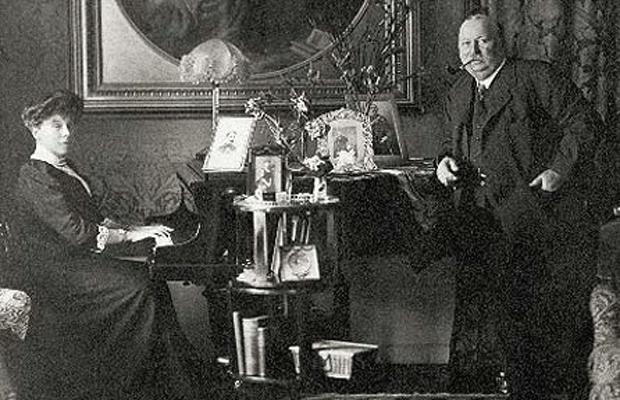
William Knox D’Arcy
The next owner of note was William Knox D’Arcy. William was one of those people who just happened to be at the right place at the right time. His amazing story started when his fathers legal firm went into bankruptcy. His father also called William decided to skip the country and take his young family with him. As far away as possible was the plan and they ended up in Rockhampton, Queensland Australia
Penniless but eager to provide for his family Elder William started another law firm which younger William joined after finishing his studies, and qualifying as a lawyer. The two got on well but after a while young William set up on his own.
One day he was in the office when three brothers came in to see him. They were after a loan to go prospecting gold and had been turned down by the local bank, although the branch manager hinted, they might be better off looking for a private investor who was willing to take a punt on them. Darcy jumped at the chance and formed a syndicate with seven others like minded individuals, together they raised the needed capital, to buy a prospecting licence for the Ironstone Mountain, some 20 miles south of Rockhampton. Some gold was found but was very slow, worried about the initially low rate of recovery, the Morgan boys sold their interests by October 1883 to the syndicate for approximately £100,000. As time went on more gold was found and profits rose.
By 1886 gold was being discovered in ever greater quantities, and ’The Mount Morgan Gold Mining Company’ was established with one million £1 shares. William Knox D’Arcy was one of the eight original shareholders and directors, with 125,000 shares in his own name and 233,000 in trust. At one stage the shares reached £17 1s. each, William became a millionaire. With his newly found wealth he lived a very comfortable life with his family in the Rockhampton But for D’Arcy the problem with Australia was, it didn’t have the class system that was alive in England, where if you had money you were somebody. So, in 1886 he sold his legal practice and moved back to England.
It was at this point that William bought Stanmore Hall, the king of gold was very much at home with his country castle. Not content with the property as it was, he employed the services of Brightwen Binyon the architect and had the Hall greatly enlarged, Binyon extended the south elevation in sympathy with the original house but added an east front in a Flemish Renaissance style. William had the interior decorated like a palace, and the gardens landscaped. He commissioned Howard & Co. to decorate the interior and from William Morris and Edward Burne-Jones a suite of tapestries; they were on the theme of the 'The Quest of the Holy Grail' . Six in total they were hung in the dining room and each one depicting a different scene from the legend of King Arthur and the quest for the Holy Grail, other work from Morris included a staircase, ceilings, fireplaces, and mosaic floors.
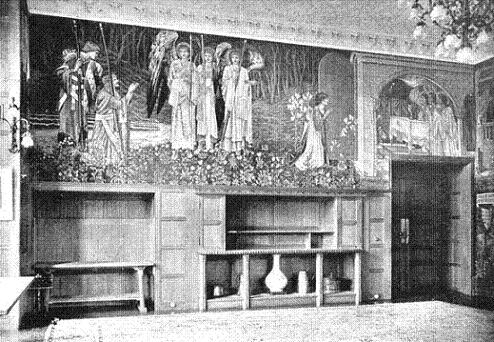
William was living the good life but all play and no work is never a good combination, the value of his Mount Morgan shares started to decline, but the cost of his extravagant lifestyle was still mounting. A new project had to be found and it came in the shape of a new mining venture, and this time it was in oil....
During 1900 D'Arcy was approached by old friend regarding a venture in oil exploration. For many years it had been rumoured about a hidden oil field in Persia. D’Arcy agreed to bankroll the project and sent an envoy who obtained a concession to search for oil over 480,000 sq. miles. The sixty-year contract gave D’Arcy exclusive rights to explore, obtain, and market oil, natural gas, asphalt, and ozocerite. In return, D’Arcy agreed to pay the Iranian government ₤20,000 in cash, ₤20,000 in stocks, and sixteen percent of the annual profits.
The dig started in earnest but two years and £150,000 later no oil was found. Running very short on funds William was forced to mortgage his Mount Morgan stock, two years later he had spent some £225,000, a considerable sum in 1905 especially with nothing to show for it. By now things were getting serious for William, overwhelmed by debt he had just sat down for supper one evening, thinking this may be one of his last at Stanmore Hall before the banks foreclosed on him, as a last resort he approached the Rothschild family over the sale of his concession. Word spread and on 20 May 1908 the British owned Burmah Oil Co. stepped in with an offer, backed by the British Government.
D'Arcy agreed to it and drew up a new contract to cover the deal. Now, under this contract, he received 170,000 Burmah Oil shares and a payment to cover all expenses he had incurred so far. He was also allowed to own whatever oil he found in Iran and pay the government just 16% of any profits he made.
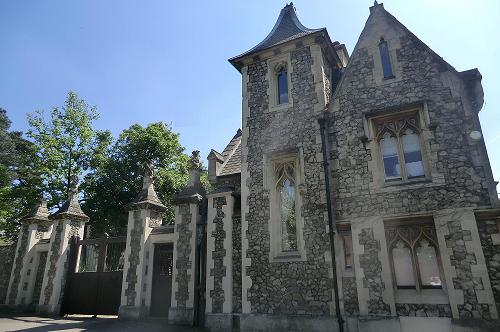
Then just six days after he had drawn up the new contract oil was found, but this was no ordinary find, his team had unearthed the biggest oilfield ever discovered in the world. After this first discovery on 26 May 1908, William Knox D’Arcy became sole owner of the entire ocean of oil that lay beneath Iran's soil. No one else was allowed to drill for, refine, extract, or sell Iranian oil. On 14 April 1909, Burmah Oil created a new subsidiary company. The new company would be called The Anglo-Persian Oil Company (AOPC). Production eventually started in 1913 from a refinery built on the port of Abadan on the Persian Gulf. For the first 50 years of its life it became the largest oil refinery in the world. D’Arcy was appointed to the board of the new company, where he remained for the rest of his life For William Knox D'Arcy to be seen to be wealthy was more important than the money itself, now better off financially William lived the life he’d always dreamt of. In 1899 just two years after divorcing Elena, D'Arcy married Nina Boucicault, daughter of Irish-Australian newspaper boss Arthur L. Boucicault. Nina was a first cousin of her namesake, Nina Boucicault, the celebrated Irish stage and film actress. She would love to entertain and he loved to spend, often throwing extravagant banquets for their showbiz and society friends at Stanmore Hall.
In 1954 D'Arcy's company which started life as a small subsidiary of Burmah Oil was renamed The British Petroleum Company. They merged with Amoco in 1998, becoming BP Amoco plc. In 2000 they acquired ARCO and their old parent company Burmah Castrol. The following year 2001, they changed their name for the last time becoming what we know today as BP plc.
William Morris
It was said that D'Arcy's lavish lifestyle emulated the future king Edward VII, and now at Stanmore Hall, William had his own castle. He employed the services of the Ipswich architect Brightwen Binyon and had the Hall greatly enlarged, and simultaneously had William Morris & Co to redecorate the interior. It was to be decorated like a palace, and the gardens landscaped. It was Morris & Co largest contract in their history, no expense was to be spared, and the work would include furniture, textiles, woodwork, carpets, metalwork and a beautiful mosaic floor. D’arcy had a fondness for oil paintings and amassed quite a collection including works by Frank Dicksee and Frederick Goodall.
Like similar Morris & Co. tapestries, this sequence was a group effort, with overall composition and figures designed by Edward Burne-Jones, heraldry by William Morris, and foreground florals and backgrounds by John Henry Dearle. The tapestries remained at Stanmore Hall until after D'Arcy's death. In 1920 along with many other features of the Hall, they were subsequently sold off and dispersed.
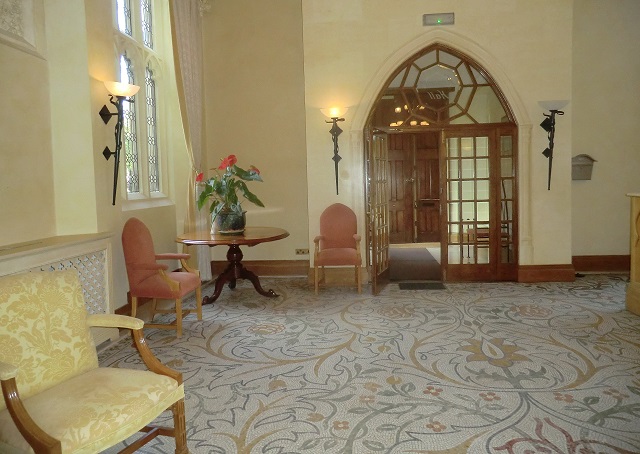
William Morris had strong socialist leanings and although he was happy to take the job and the money, he was rather patronising about Stanmore Hall and Brightwen Binyon, writing of them on 10 June 1890 as "a sham Gothic house of 50 years ago now being added to by a young architect of the commercial type men who are very bad. Fancy in one room there was not a pane of glass that opened." Manchester born Binyon was a student of Alfred Waterhouse whose primary work was schools and library’s which may have been the source of Morris’s mocking remarks.
He hated the way that the locals would touch their caps as D’Arcy would pass them. Writing to his wife in 1888 Morris stated. “Our client sent his carriage to meet me and I couldn’t help laughing to see the men I met touching their hats, clearly not to me, but to it”
D'Arcy died on 1 May 1917 aged 68 at Stanmore Hall of broncho-pneumonia, survived by his wife and children. It was estimated his estate to be worth some £984,000 a considerable sum of wealth in 1917, and would be the equivalent of nearly £50 million today. His death was widely reported locally, nationally and internationally, the founder of the oil industry in the Middle East was dead. Dignitaries and celebrities attended his funeral in Stanmore and the route was lined with spectators as the hearse drawn by horses with black plumes slowly carried the coffin through the village on his final journey to the church of St. John the Evangelist for the service.
'Gremlin Castle'
After D’Arcy's death in 1917, the house and contents were put up for sale, this would be the last time that the Hall was used as a family home. During the second world war the military build-up for operations at Bentley Priory increased, private residences were commandeered for the war effort and used primarily as billeting centres for the personnel and officers working there. Stanmore Hall was requisitioned as accommodation and as a mess for ninety officers of the Allied Expeditionary Air Force in 1943 – 1944. The Allied Expeditionary Air Force was an element of the Supreme Headquarters Allied Expeditionary Force which controlled the tactical air power of the Allied forces during Operation Overlord. Operation Overlord was launched on 6 June 1944 with the Normandy landings, commonly known as D-Day. King George VI, Prime Minister Winston Churchill and US General Dwight Eisenhower monitored the landings from the Allied Expeditionary Air Force War Room, a bunker which was constructed at Bentley Priory. During the officer’s time at Stanmore Hall they affectionately christened the Hall 'Gremlin Castle'.
The Hall used as a film location
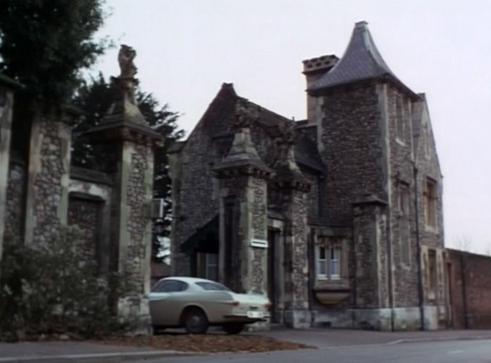
The great setting is perfect for film location, near enough to London but hidden away from prying eyes. Through the years the exterior of the hall has been used in many TV programmes and movies including;
Randall and Hopkirk (Deceased) - 'All Work and No Pay'
The Baron - 'The Man Outside'
The Avengers - 'From Venus with Love', 'The Winged Avenger'
The Champions - 'The Final Countdown'
The Adventurer - 'Icons are Forever'
The Professionals - 'Blind Run', 'Need to Know'
And The Saint with our very own Local celebrity Rodge Moore who lived for a time in Gordon Avenue, episodes including - 'The Hi-jackers', 'The Rhine Maiden', 'The House on Dragon's Rock', 'The Ex-King of Diamonds'
The Hall became the home of Baron Frankenstein in the 1969 Hammer Classic Frankenstein Must Be Destroyed, starring the horror legend Peter Cushing as the mad scientist Victor Frankenstein.
Peter Cushing returned to the Hall four years later with his old movie partner Christopher Lee to make the British horror ‘Nothing but the Night’ the hall being the setting of ‘Inver House’ an orphanage full of demonic children.
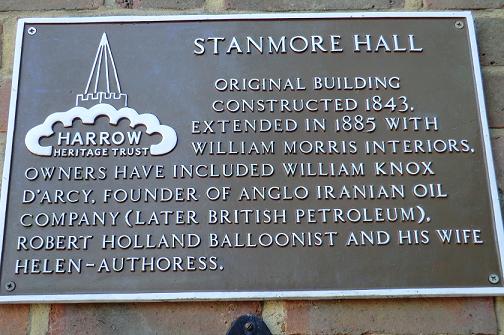
In 1971 the Hall was given grade II* listed status by Harrow Council, which should have afforded the property a degree of protection. For a while the hall was used by the Royal National Orthopaedic Hospital, and was turned into a nurse’s home. With little maintenance the structure of the Hall deteriorated with rampant dry rot, in 1977 it was eventually sold by the area health authority. The building was bought by a property company for the princely sum of £85,000. Falling further into disrepair, the unloved and neglected house was vandalised, two years later in 1979 under spurious circumstances the building was set ablaze, being so high up the flames could be seen from miles around, water used to extinguish the blaze compounded the damage, and it looked like it was all over for Stanmore Hall. On inspection surveyors reported that the damage was localised and the structure could be saved. During restoration new wings were added with offices, accommodation and even a swimming pool. The newly refurbed building was used by a computer software company and then became UK headquarters for Volvo.
In 1998 The site was converted by contractor Relicpride into 22 luxury apartments with 2.5 acres of historic grounds. The building has received Harrow Heritage brown plaque which is attached to the wall by the main gate in recognition of the building and its owners.
From time to time apartments can be seen for sale in the local estate agents. It has been rumoured by some of the agents that since the conversion, residents have included Tom Cruise, Nicole Kidman, and Leonardo DiCaprio, a nice story but unfortunaly not true, although I’m sure they would be more than happy with the place if they ever came looking.
